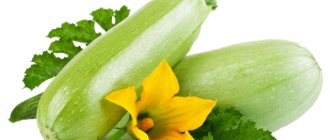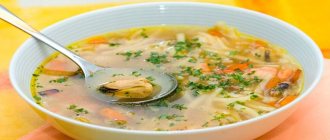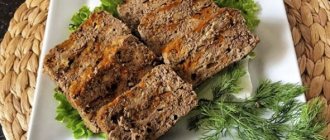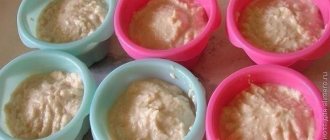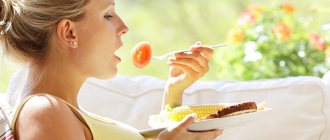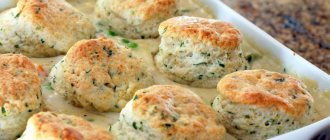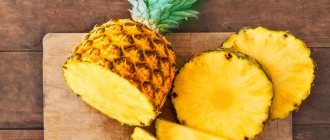Home Children Food
At the age of one year, the child must begin to be accustomed to “adult” food. This, of course, should be done gradually: after all, the baby’s digestive system still remains immature. The first step towards a common family table should be a gradual rejection of “baby” food in the form of liquid puree. However, this form of food processing is not prohibited at all. Agree, both adults and children love mashed potatoes and liver pate.
Products for a one-year-old baby should not be crushed in a blender, as you are used to doing before, but with the help of a fork or a special masher. Thus, the baby will learn to chew small pieces of food. By the age of one year, a baby already has several teeth (on average eight) - you need to learn how to use them!
If up to this point you preferred to feed your child ready-made “canned” food, it’s time to start gradually reducing the share of “jars” in the child’s diet. It's time for the baby to get used to the range of tastes, colors, smells and thickness of the dishes that are served to the table in his family.
If after a year the mother and child consider it necessary to continue breastfeeding, good. However, you should know that at this age, breast milk for a baby is mainly not food, not a source of essential nutrients, but a symbol of closeness with the mother, a means of calm, and sometimes entertainment. And the baby gets everything necessary for its growth and development with normal “human” food.
If the baby refuses to eat, put the food on a multi-colored “rainbow” plate. Scientists have proven that the bright colors in which the dishes are painted stimulate the appetite!
Nutrition for young children
What to feed a child per year? The baby should eat 5 times a day. Dairy products remain the basis of the diet (700 grams daily). Kefir and natural cottage cheese are very useful. In the first half of the day, serve lean meat in the form of steamed cutlets or meatballs. Replace it with lean fish once a week. The baby should receive an egg every other day. Also add liquid cereals (for breakfast) and vegetables to the menu. Cut the fruit into small pieces.
At 2 years old, you can switch to four meals a day. It is best to have thick porridge for breakfast. Lunch should be the most high-calorie meal. In the third year of life, you can introduce your baby to legumes and liver. Stew vegetables in pieces, add garlic and onion. Among sweets, cookies, marshmallows, marshmallows, marmalade, and cocoa are acceptable. With candy, cakes and soda, wait until age three. If you are wondering what to feed your child for dinner, give preference to light dishes: cottage cheese, vegetables, yogurt with fruit. Eliminate fried, salty and spicy foods and processed foods from your diet.
Nutrition of a child at 3 years old
From three to seven years of age, a child becomes very active, so food for this period should be rich in energy resources - carbohydrates.
Priority remains with boiled and stewed dishes baked in the oven. Occasionally you can cook fried dishes, but, of course, without fried crusts. You should not add hot seasonings to baby food: ketchup, soy sauce, hot pepper, horseradish, vinegar, mustard, adjika, mayonnaise. You can make your own mayonnaise for children using lemon juice and olive oil. You can season a meat dish for a child using cranberry sauce or just lemon juice.
Meat for a child three to seven years old should also be of low-fat varieties.
You can use onion, garlic, parsley and dill; they are a storehouse of vitamins, but chop them well and add them to the dish in moderation. A small child will not like a dish heavily seasoned with herbs.
But fresh fruits, berries and vegetables will please your baby.
Include sandwiches with soft or hard cheese in your three-year-old child's diet. Actively use sour cream and cream for cooking. Yogurt and cottage cheese will be beneficial for your baby.
For drinks, children can be given weakly brewed black or green tea, or natural kvass. Do not teach your child to drink food with drinks, especially meat. For processing and absorption, the body produces gastric juice. And it is extremely harmful to dilute it when digesting with liquids. Therefore, it is better to give drinks to children 10-15 minutes after eating the main dish.
Read the article: “The healthiest cereals for breakfast”
Preschooler nutrition
After three years, your child can eat almost all foods, with the exception of mushrooms and coffee. It is better to wait with them until 6-7 years. Teach your child to healthy food, avoid fast food. Include milk, bread, fruits and vegetables, meat, butter, and juices in your daily menu. Give your baby cheese, eggs, fish, sour cream, pasta 2-3 times a week, limit sausages to 1 time. Delicacies and smoked meats can irritate a child’s stomach, but on holidays you can eat a piece.
Four meals a day are optimal. For breakfast, the easiest way is to prepare porridge or an omelet, as well as cottage cheese with fruit. Lunch should consist of a vegetable salad (50 g), soup (200 g), a meat or fish dish with a side dish (80 g), juice or fruit. For an afternoon snack, offer fruit, a bun, or cookies. For drinks, serve milk, compote, juice, kefir or jelly. What to feed your children in the evening so that they sleep soundly? Recommended meals include cereals, cottage cheese, and vegetables 1.5 hours before bedtime.
Nutrition after a year
Many children have already tried basic foods by the age of one year. What you can feed your child is a question that should not confuse parents. Now it won’t be difficult to come up with a menu for your little one for the day. The baby's diet should be varied: meat, fish, cereals, pasta, fermented milk and dairy products, vegetables and fruits. The time that should pass between meals is 3.5-4 hours. The daily menu consists of 4-5 meals. In this case, before going to bed, it is better to give the child kefir or yogurt, milk formula. By the age of one and a half years, you can add the “right” sweets to your child’s diet: honey, marshmallows, jam. It is better to wait until three years to use sweets and chocolates.
Porridge
Don't know what to feed your child for dinner or breakfast? Cook the porridge. Cereals contain many useful substances: starch, vitamins B and E, iron, amino acids, vegetable fats. Up to 3 years old, cook semi-viscous and viscous porridge for children. In the first case, 4 times more water is taken than cereal. For viscous porridge the ratio is 3:1, respectively. You can also make puddings and souffles from cereals.
To do this, take 4 tbsp. l. semolina or rice, cook a semi-viscous porridge. Add 4 tsp. melted butter. Grind the yolk with 4 tsp. sugar, dilute a little with water and pour into the mixture. Grated carrots, apples, peach or apricot puree will help make the dish tastier. Beat the egg white and carefully fold it into the mixture. To obtain a soufflé, the mixture is poured into molds and cooked in a water bath. To make the pudding, the mixture is baked in the oven.
Comparative characteristics of the diet up to 3 years
| Main characteristics | From 1 to 1.6 years | From 1.6 to 3 years |
| Number of teeth a child has | 8-12 pieces, front incisors and chewing premolars. It is possible to bite and chew only soft foods. | 20 teeth, all groups of teeth for both biting and chopping and chewing food |
| Stomach volume | 250-300 ml | 300-350 ml |
| Number of meals | 5 meals a day | 4 meals a day |
| Volume of one meal | 250 ml | 300-350 ml |
| Daily food volume | 1200-1300 ml | 1400-1500 ml. |
| Calorie distribution of meals |
|
|
It is also necessary to know what foods a child under the age of one and a half years can eat, and what basic characteristics food products for children should have. Here is a sample list of these products.
Soups
What can you feed your child to satisfy the body’s need for vegetables, meat and water at the same time? Of course, soup. True, modern pediatricians are cautious about meat broth, since when it is cooked, extractive substances are released. It is difficult for an immature digestive tract to absorb them. Therefore, cook vegetarian soups for up to one and a half years. Later, use lean beef, veal or boneless pork for broth. You can cook the turkey or chicken whole. The best fish to choose is cod, perch or pike perch.
How to cook vegetarian borscht? Grate 50 g of beets and 20 g of sour apple, cover with water, add 0.5 tsp. butter and simmer covered for a quarter of an hour. Meanwhile, cut 40 g of potatoes, chop a circle of carrots, onions, and parsley root. Add them to the bowl and simmer for another 10 minutes. Then pour half a glass of water, add 50 g of shredded cabbage and a quarter of chopped tomatoes. After 10 minutes the borscht is ready. For a one-year-old baby, you need to put it through a blender, add sour cream, herbs and serve.
Salads
What should I feed my child so that his body gets enough vitamins? The best option is salads made from fresh vegetables. They should be prepared daily and served as a snack. Until one and a half years, vegetables are grated on a fine grater, after which - on a coarse grater. If your baby is over 2 years old, the ingredients can be finely chopped. Sour cream, vegetable oil, lemon juice, and yogurt are suitable for dressing.
You can prepare the following simple salads:
- "Green". For it you take a cucumber, two or three onions and lettuce leaves.
- "Beetroot". It is prepared from boiled beets and steamed prunes. Use vegetable oil and a drop of lemon juice as a dressing. You can also add sugar.
- Apple and carrot salad with sour cream.
- Cabbage salad with lingonberries. Add some green onions and season with vegetable oil.
How many times do children eat?
After the child turns 1 year old, we can gradually switch to four feedings a day: breakfast, lunch, afternoon snack, dinner.
Between breakfast and lunch, you can give your child one of the fruit juices or an apple. From one to one and a half years, the child’s daily food volume should be 1000-1200 ml. And from one and a half to three years - up to 1400 ml. Of course, the indicated volumes should not be maintained too strictly, since much depends on the type of food and its nutritional value. After 2 years, children switch to three full meals a day with two snacks between meals. On average, a child should eat 1,500 ml of food per day.
From 4 to 5 years of age, a child should receive an average of 2,000 ml of food. It is better to distribute the total amount of food approximately like this: 30% - breakfast, 35% - lunch, 15% - afternoon snack, 20% dinner.
Table. Daily set of products for children
Compiled by: K.S. Ladodo, L.V. Druzhinina
Meat dishes
The kids are growing actively and need protein. During the week they need 4-5 meat dishes and 2-3 fish. It is preferable to use beef, veal, chicken, rabbit and turkey. It is better to exclude fatty meat (goose, duck). The same goes for fish. Recommended by-products include liver, tongue, and brains. Let's look at a couple of simple recipes. How to feed children so that they eat meat on both cheeks?
- Steam cutlets “Mice”. Take 50 g of lean beef. Soak 10 g of white bread in milk. Grind them through the meat grinder twice. Add 2 g butter, salt, form into oblong cutlets. Steam for 25 minutes. Before serving, make ears from carrot circles, eyes from green peas or peppers, and a tail and mustache from parsley. The mouse is ready.
- Rice with meat. Cut 150 g of lean meat into pieces, boil and mince twice. 3 tbsp. l. Boil rice in water. Mix everything. Place the dish on a plate, forming the body and head of a sheep. Make legs from green onions, eyes from peas, and ears and a mouth from a cut red apple. Children will happily eat the funny character.
Dairy dishes
Each child should receive at least 500 g of milk and fermented milk products per day. Cottage cheese and sour cream can be given 3-4 times a week. All this is offered to children in its natural form, and is also used to prepare porridges, soups, casseroles and desserts.
How to make cottage cheese casserole? Pour a quarter glass of milk into a bowl, soak 1 tsp in it. decoys. While the mixture is swelling, grind 1/4 egg with 1 tsp. Sahara. Mix with semolina. Add grated cottage cheese (5 tbsp), a little apple or banana. Place the mixture in a greased pan and bake.
The finished dish can be topped with milk sauce. To prepare it you will need half a glass of milk. Initially, take just a little liquid, dilute 1 tsp in it. flour. Stir so that there are no lumps. Boil the rest of the milk and pour into the flour solution. Put 1 tsp. Sahara. Boil for exactly 5 minutes, add 1 tsp. butter. Cool and serve with cottage cheese casserole, cheesecakes or dumplings.
Recipes for children's dishes for afternoon tea
An afternoon snack for a child is often simple: a cup of tea and cookies, a glass of cocoa and a fruit puff, jelly and dried fruit. If mom is not in a hurry, you can prepare a roll or pudding according to the recipe, which is served with honey, jam, caramel or chocolate.
READ ALSO: the best recipes for children's dishes for children from 1 year old
- To prepare the cottage cheese casserole, you need to mix a glass of chopped oatmeal, 2 tbsp. l. sugar, a pinch of salt and baking powder. In another plate, grind 2 bananas and 500 g of cottage cheese. The prepared mixtures are mixed, placed in a mold and baked in a preheated oven until golden brown.
- To prepare the roll, beat 3 eggs with 2 tbsp. l. hot water, gradually mixing 2 tbsp into the mixture. l. sugar, a glass of flour and baking powder. Place the finished mixture on a baking sheet and place in the oven. To prepare the filling, 250 g of cottage cheese are mixed with 2 tbsp. l. sour cream, 150 g of softened butter and condensed milk. The curd mass is wrapped in a cooled cake, which is put into the refrigerator for several hours.
- For a 2-3 year old baby, you can prepare a soft, creamy pudding. According to the recipe, you need to beat 0.5 cups of sugar and 4 chicken eggs with a mixer, add 3 tbsp. l. flour and 200 g sour cream. The dough is placed in a mold greased with butter, so that it does not exceed 1/2 of the container, and put in the oven until golden brown.
- To prepare a milkshake, you need to beat 100 ml of milk, a handful of berries, 2 tsp in a blender. low-fat yogurt or cottage cheese. The advantage of the drink, in addition to ease of preparation, is the ability to combine ingredients. Instead of berries, you can use honey and nuts.
INTERESTING: how to make delicious cheesecakes for children?
Dessert
Instead of sweets and cakes, it is healthier to accustom children to fruits. A preschooler should eat 200-300 g of them per day. Juices are also necessary. You should be careful with berries, especially allergenic strawberries. For variety, you can make your own sweets.
How to feed a child if he demands something tasty? Let's learn how to make milk jelly. Take 150 g of hot milk, add sugar to taste, lemon zest and a little vanillin. While the drink is infusing, pour 5 g of gelatin with cold water. After an hour, when it swells, pour it into boiling milk. Move, strain and pour into molds for further hardening.
A hearty cocktail is prepared very quickly. For it you will need berries, including frozen ones, or soft fruits (bananas, peaches, etc.). Place them in a blender. Pour half a glass of oatmeal, pour milk, add sugar to taste. Beat the mixture well and serve.
Bakery
Bread must be included in the baby’s diet. Among the sweet baking options, you can give your one-year-old baby baby cookies or crackers. From the age of one and a half, introduce your child to bagels, crackers, biscuits and oatmeal cookies. It is better not to give buns, shortcrust pastry, crackers until 3 years of age. They contain unhealthy fats and a lot of sugar or flavorings. Of course, the best option is homemade baking.
What to feed a child to a loving mother? We offer to bake classic children's cookies. To do this, beat 3 eggs and an incomplete glass of powdered sugar with a mixer. The volume should increase 2-3 times. While stirring the mixture, add about 160 g of flour. Grease the baking tray. Squeeze the dough onto it from a pastry syringe in the form of long strips. If you don’t have a syringe, you can take a regular plastic bag and make a hole in it in one of the corners. You need to leave some free space between the strips.
The cookies are baked over medium heat until golden brown. The strips are removed with a knife. They can be given any shape: braided, bent in any direction. Older kids enjoy playing this game.
Where do the “unwanted people” come from?
Many adults wonder how to feed a small child. Children pick at their plates for a long time, spin around in their chairs and refuse tasty food. Parents have to put on entire theatrical performances in front of their whims, turn on cartoons to distract attention and shove another spoonful of porridge into their mouth.
Why is this happening? Let's look at the most common reasons:
- Disease. A child may refuse to eat if he feels unwell or is in pain (for example, he is cutting a tooth).
- Stress. Many children begin to eat poorly during the period of adaptation to kindergarten, when a younger brother appears in the family, and also in cases when the dinner table becomes a place for a “showdown.”
- Individual characteristics. Thin children eat less than their well-fed peers.
- Wrong mode. If the family leads a sedentary lifestyle, if the baby can always snack on candy or cookies, then he simply does not feel hungry.
- Heat. In summer, both children and adults eat less.
What to cook for a 2-year-old child if he doesn’t eat well?
There are only a few ways to interest your child in food:
- In a playful way (when you try to make him imagine that a spoon with food is an airplane, a train, or a car that wants to get into the garage - his mouth).
- Offer an incentive (we mean that you will encourage the child to eat well with something interesting for him: a walk in the park, joint entertainment, toys).
- Set an example (children often strive to be like their parents, so you should show how happy you are to eat this particular food and how tasty the food is).
- Praise your child for every spoonful he eats (this will encourage your child to “be good” to you and eat everything).
- Tell other family members about the child’s “successes” (for example, tell this to the baby’s dad and he will be proud of himself).
- Offer to cook food together (the baby will definitely want to try his own food, it’s not difficult, for example: throwing vegetables into a salad bowl or stirring porridge).
What not to do:
- Promise sweets (they set up the child to eat “not tasty” food before “tasty”).
- Threaten with punishment (this will cause the child to have negative associations with eating).
- Forcibly insert a spoon into the mouth, open the mouth against the will (this will compare the child’s eating with torture; allow the baby to “pick” the food on his own, because this will interest him).
IMPORTANT: If the child is not attracted to the food, make it beautiful. Every child will appreciate porridge, a sandwich or hot food in the shape of a bunny, cat or bear. He will definitely want to try his nose, tail, ear, and so on.
“Beautiful” dishes for children, serving options:
Fruits laid out with pictures
Mashed Potato Machine
Turtle from buckwheat porridge
Sandwiches “faces”
Bear made from mashed potatoes and cutlets
How to solve a problem?
If your child has no appetite, follow this plan:
- Go to the doctor, get tested.
- Study the nutritional standards for children. Perhaps it just seems to you that your child is not eating enough.
- Every mother knows what to feed her child if he doesn’t eat anything. Chocolate, ice cream, and chips go well, as they curb your appetite. Therefore, we completely exclude snacks.
- The baby should move a lot and walk outside, then he will have time to get hungry.
- Buy attractive dishes, place a beautiful napkin on the table, and decorate the dish in an unusual way.
- Use small portions so that the child is not frightened by large amounts. Better to ask for more.
- Children eat better in company. Place your baby at a common table or place toys on chairs.
- Do not force your baby to eat, do not lure him with cartoons. Appetite often appears when adults stop being nervous and putting pressure on the child.
Why does my child eat poorly?
Causes of poor appetite that are not related to health can be grouped into five groups:
- The child eats only those foods that he likes best in terms of taste. Parents often complain that children do not eat cereals, soups, or meat dishes at all. But they don’t need to be forced to eat fruits, sweets or, for example, sausages. In this case, we are not talking about the child’s poor appetite, but about selective appetite. If parents are satisfied with this, then nothing needs to be changed. Otherwise, explain to the child that porridge is for breakfast, soup for lunch, and cottage cheese casserole for dinner. And there can be no alternatives. If the baby refuses the proposed dish, then let him know that the next meal will be in 3-4 hours. We will reassure those who are especially worried that their child will suffer from hunger. If you adhere to the intended tactics and do not offer your child other food, then soon he will happily eat what you have prepared.
- The second reason has a bit in common with the first - snacks. If the baby constantly interrupts his appetite with various snacks, then, of course, he will not want to touch the soup that his mother lovingly prepared. In this case, it is also recommended to limit the child’s snacking between main meals.
- A child is an individual. He may have his own digestive characteristics, his own growth rate, and type of character. For example, one baby runs and jumps like a top all day long and doesn’t sit still for a second, while another, on the contrary, loves quiet games, sitting with a book, drawing. The calorie content of the daily menu in the first case may be higher, but the first baby is thin, and the second is plump. Consequently, a child’s appetite directly depends on physical activity. The baby's stage of development also influences the desire to eat. Children in the active growth phase have an increased appetite. The main thing to focus on when deciding to enroll your child in the ranks of little ones is compliance with his level of development.
- The next point follows from the previous one. Children who are actively involved in sports, as a rule, do not suffer from the problem of poor appetite. After all, the energy spent on physical exercise must be replenished. And a sporty child will never refuse the offered dish.
- Often children who refuse to eat hear from their elders: “Until you eat, you won’t leave the table,” “If you don’t eat, you won’t grow,” “If you don’t eat, you won’t get sweets/toys/cartoons.” Such tactics of manipulation and threats do not lead to the appearance of appetite. Therefore, if a child refuses to eat, do not force him; if he gets hungry, he will eat.
Selective appetite
How to feed a child if he refuses healthy vegetables or tasty soup? The problem of selective appetite lies in improper upbringing. The child realized that he could manipulate his parents and demanded only his favorite food.
The best solution if your baby doesn’t want to eat carrot soup is to calmly send him to play. After 2 hours, offer the same dish. Don't give up after the second or third try, pulling out the required mac and cheese from the bins. Be decisive but friendly. This is the only way to defeat the stubborn little one.
It will become a good tradition in the family to try all new dishes. If the product does not inspire confidence in the child, let him eat at least one spoon. Explain that by doing this we are thanking the person who prepared lunch for us.
Feeding a child tasty food is a difficult task, but it can be done. Cook with love for your kids, sit down at the table in an exceptionally good mood, and nutrition problems will solve themselves.

